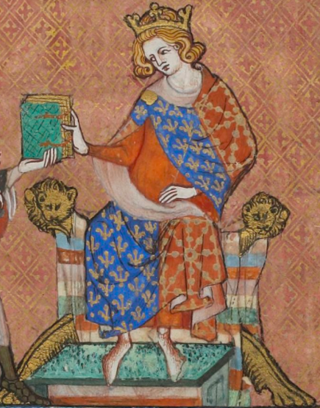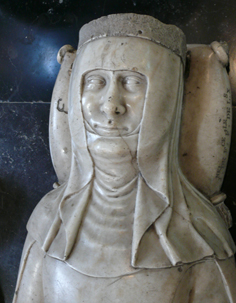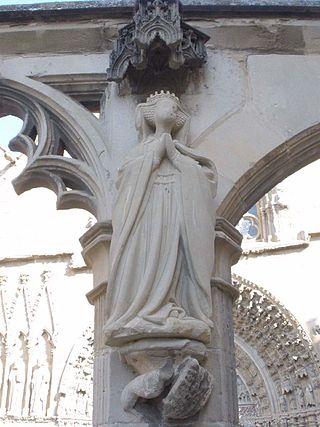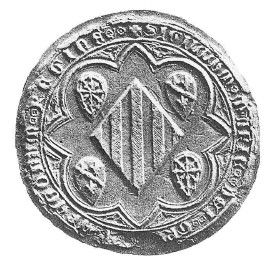Related Research Articles

Philip IV, called Philip the Fair, was King of France from 1285 to 1314. By virtue of his marriage with Joan I of Navarre, he was also King of Navarre and Count of Champagne as Philip I from 1284 to 1305. Although Philip was known to be handsome, hence the epithet le Bel, his rigid, autocratic, imposing, and inflexible personality gained him other nicknames, such as the Iron King. His fierce opponent Bernard Saisset, bishop of Pamiers, said of him: "He is neither man nor beast. He is a statue."

Louis X, known as the Quarrelsome, was King of France from 1314 and King of Navarre from 1305 until his death. He emancipated serfs who could buy their freedom and readmitted Jews into the kingdom. His short reign in France was marked by tensions with the nobility, due to fiscal and centralisation reforms initiated during the reign of his father by Grand Chamberlain Enguerrand de Marigny.

Philip III, called the Bold, was King of France from 1270 until his death in 1285. His father, Louis IX, died in Tunis during the Eighth Crusade. Philip, who was accompanying him, returned to France and was anointed king at Reims in 1271.

Philip V, known as the Tall, was King of France and Navarre from 1316 to 1322. Philip engaged in a series of domestic reforms intended to improve the management of the kingdom. These reforms included the creation of an independent Court of Finances, the standardization of weights and measures, and the establishment of a single currency.

Charles IV, called the Fair in France and the Bald in Navarre, was last king of the direct line of the House of Capet, King of France and King of Navarre from 1322 to 1328. Charles was the third son of Philip IV; like his father, he was known as "the fair" or "the handsome".

Charles III, called the Noble, was King of Navarre from 1387 to his death and Count of Évreux in France from 1387 to 1404, when he exchanged Évreux for the Duchy of Nemours.

Joan I was ruling Queen of Navarre and Countess of Champagne from 1274 until 1305. She was also Queen of France by marriage to King Philip IV. She founded the College of Navarre in Paris in 1305.

Joan II was Queen of Navarre from 1328 until her death in 1349.

Walter V of Brienne was Duke of Athens from 1308 until his death. Being the only son of Hugh of Brienne and Isabella de la Roche, Walter was the heir to large estates in France, the Kingdom of Naples, and the Peloponnese. He was held in custody in the Sicilian castle of Augusta between 1287 and 1296 or 1297 to secure the payment of his father's ransom to the Aragonese admiral Roger of Lauria. When his father died fighting against Lauria in 1296, Walter inherited the County of Brienne in France, and the counties of Lecce and Conversano in southern Italy. He was released, but he was captured during a Neapolitan invasion of Sicily in 1299. His second captivity lasted until the Treaty of Caltabellotta in 1302.

Blanche of Artois was Queen of Navarre and Countess of Champagne and Brie during her marriage to Henry I of Navarre. After his death she became regent in the name of their infant daughter, Joan I. She passed on the regency of Navarre to Philip III of France, her cousin and her daughter's prospective father-in-law, but retained the administration of Champagne. She later shared the government of Champagne with her second husband, Edmund, until her daughter reached the age of majority.

The House of Ibelin was a noble family in the Crusader Kingdom of Jerusalem in the 12th century. They rose from relatively humble beginnings to become one of the most important families in the kingdom, holding various high offices and with extensive holdings in the Holy Land and Cyprus. The family disappeared after the fall of the Kingdom of Cyprus in the 15th century.

Philip III, called the Noble or the Wise, was King of Navarre with his wife Joan II from 1328 until his death in 1343. He was also Count of Évreux in France from 1319.

The County of Champagne, was a medieval territory and feudal principality in the Kingdom of France. It developed on the rich plains between Paris and the border of the Holy Roman Empire in the 12th century. It became an economic hub of northern France and an international trade center in part due to the trade fairs instituted by Count Theobald II, and steady land clearing led to economic and urban growth. Count Henry the Liberal established the city of Troyes as the county's capital and expanded the state. The court of Champagne under Count Henry and Countess Marie saw a proliferation of literary authors. In the 13th century, Count Theobald III, Countess Blanche, and Count Theobald IV oversaw a centralization of the state. The county is noted for its support to the crusades and monastic foundations, especially those of the Cistercians, which originated within its borders. From 1234 the count of Champagne was also the king of Navarre, and the marriage of Queen Joan I of Navarre with King Philip IV of France led to the county being absorbed into the royal domain of the kings of France in the 14th century.

Joan of England was by marriage Queen of Sicily and Countess of Toulouse. She was the seventh child of King Henry II of England and Duchess Eleanor of Aquitaine. From her birth, she was destined to make a political and royal marriage. She married William II of Sicily and later Raymond VI, Count of Toulouse, two very important and powerful figures in the political landscape of Medieval Europe.

Blanche I was Queen of Navarre from the death of her father, King Charles III, in 1425 until her own death. She had been Queen of Sicily from 1402 to 1409 by marriage to King Martin I, serving as regent of Sicily from 1404 to 1405 and from 1408 to 1415.
Isabella of Ibelin (1241–1324) was queen of Cyprus and Jerusalem by marriage to Hugh III of Cyprus.

Maria of Navarre was Queen of Aragon from 1338 until her death as the first of four wives of Peter IV of Aragon.
Constance of Sicily was Queen of Cyprus and Jerusalem by marriage to Henry II of Cyprus and Queen of Armenia by marriage to Leo IV of Armenia.
Joan of Navarre was the heiress presumptive to the throne of Navarre in 1402–1413, and regent of Navarre in the absence of her father in 1409–1411.
Joan of Navarre was a princess from the French House of Évreux, the eldest child of King Philip III and Queen Joan II of Navarre.
References
Citations
- ↑ Woodacre 2013, p. Chart I.
- ↑ Woodacre 2013, p. 45.
- ↑ Stopka 2016, p. 233.
- ↑ Edbury 2005, p. 72.
- 1 2 Anselme 1726, pp. 83–85
- 1 2 3 4 Anselme 1726, pp. 87–88
- 1 2 Evergates, Theodore (2011). Aristocratic Women in Medieval France. University of Pennsylvania Press. p. 80.
- 1 2 3 4 Anselme 1726, pp. 381–382
Bibliography
- Anselme de Sainte-Marie, Père (1726). Histoire généalogique et chronologique de la maison royale de France [Genealogical and chronological history of the royal house of France] (in French). Vol. 1 (3rd ed.). Paris: La compagnie des libraires.
- Woodacre, Elena (2013). The Queens Regnant of Navarre. Palgrave Macmillan. ISBN 9781137339157 . Retrieved 13 June 2022.
- Stopka, Krzysztof (2016). Armenia Christiana: Armenian Religious Identity and the Churches of Constantinople and Rome (4th-15th Century). Jagiellonian University Press.
- Edbury, Peter W. (2005). "Franks". In Konnari, Angel Nicolaou; Schabel, Christopher David (eds.). Cyprus: Society And Culture 1191-1374. Brill. pp. 63–102.